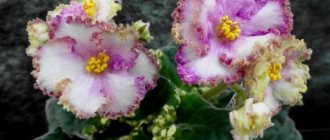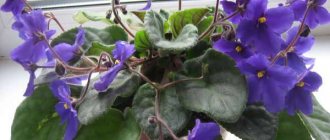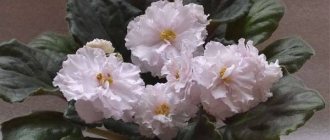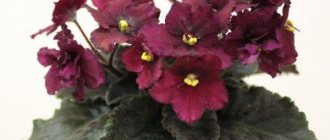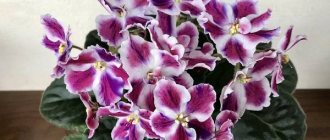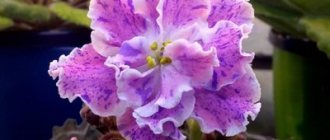The first specimens of the newly discovered Uzambara violet, which appeared at the world flower exhibitions more than a hundred years ago, won the hearts and minds of flower growers around the world with their delicate beauty, long flowering and relatively simple care in indoor cultivation.
Thanks to their beautiful appearance and ease of care, Saintpaulias quickly spread throughout home collections and took pride of place on shelves, racks and window sills.
Breeders immediately got involved in improving the varietal and decorative qualities of these tropical beauties.
Various breeding schools and private masters of breeding new varieties received various varieties and created entire lines under brand names.
But all these varieties were of interest mainly to enthusiastic flower growers and collectors who were ready to wait for a leaf from a violet they liked, nurture it into an adult plant, and then distribute the variety in the same leaf way.
Most lovers of beautiful violets did not want to endure such torment - it was easier to go to a flower boutique and purchase a ready-made copy of Saintpaulia for yourself or as a gift.
Industrial varieties were invented for this part of humanity . You can always find them in the store, they independently form an aligned rosette, bloom magnificently and for a long time.
But industrial varieties have important drawbacks: most of them are single flowering plants - you bought a violet, it bloomed and died.
Such varieties are very difficult to grow in home collections and cannot be propagated by leaf cuttings . Therefore, each gardener will have to make the choice of which violet to purchase for the collection - varietal or industrial. One of the groups of industrial varieties can be called Valeska violets.
Varieties of Valeska violets: Blue, Pink, Viol, Rosarot, Red (A. Fischer) are produced industrially in the German city of Hanover at a private enterprise for the creation and cultivation of Saintpaulias.
This company, one of the most significant and largest in the countries of the Old World, is headed by the master of selection Arnold Fischer. The company was founded in 1932, but the production of Saintpaulias began here in 1980.
IMPORTANT! Currently, A. Fischer’s company is the most powerful supplier of Uzambara violet babies to the world industrial Saintpaulia market.
Violet Valeska Blue
Saintpaulia from the industrial series . Selection by A. Fisher.
Photo of Valeska Blue violet.
Description
The violet independently forms a very aligned leaf rosette with a contour of a symmetrical configuration, classified according to the standard type .
The rosette is distinguished by its dense filling and beautiful arrangement of leaves on tiers - the leaf plates are fitted to each other, like a tiled roof structure.
leaves are distinguished by their small size, heart-shaped shape, clear venation pattern, smooth surface structure and color in the tone of summer greenery. The edge of the leaf blades has finely rounded serrations.
flowers , like a bouquet. The corollas are represented by pansies of considerable size and simple filling.
The main field of flowers has a white color, the lower three petals closer to the marginal edge bear large prints of a blue-bluish range, the two small upper segments remain unpainted.
ATTENTION! An important feature is the erect and strong peduncles, thanks to which the variety always has a chic bouquet above the rosette during flowering.
Sports
Violet is capable of occasionally forming sports with a variegated rosette and completely blue corollas. The variegation of the leaves decreases during the formation of buds; after the flowering phase, the light pattern is restored in all its glory.
Features of maintenance and care
For industrial varieties, violet is very finicky , despite the fact that it does not require the intervention of the grower in the process of forming a rosette.
When grown indoors, Saintpaulia forms buds quite late - a year after the baby takes root. It is almost impossible to propagate the variety at home.
The color intensity of blue spots fluctuates due to changes in temperature and light levels:
- a cool microclimate helps lighten the tone of the spots on the petals;
- At high temperatures, the corollas can turn completely blue.
ATTENTION! Due to low lighting, the violet appears blue. These properties should be taken into account when caring for it.
With a sufficient level of lighting, violets bloom without interruption, forming lush bouquets. Care should be taken to place the variety on the windowsill, since the plant loves the natural spectrum of light and will not want to bloom on a shelf.
Reviews
Gennady Viktorovich. “I have a very special relationship with the Valeska Blue variety - this is the first violet I bought. I’m surprised I had the strength to leave it after arriving from the store. But now we are friends with her, although she blooms extremely rarely.”
Ekaterina Pavlovna. “I accidentally came across a photo and description of the Valeska Blue violet on the Internet and I really liked it, so much so that I was eager to buy it. But a friend dissuaded me from buying it, saying that these varieties do not like to live long at home. I obeyed, but now I regret it.”
Violet Blue Danube
This variety was bred in Russia and is one of the brightest representatives among violets.
It has wavy, matte leaves with small green teeth.
The flowers are large, reach five centimeters in diameter, and are blue in color. It blooms very profusely. This variety loves well-lit growing areas and is demanding of moisture.
The duration of flowering depends very much on maintaining the correct temperature.
This indoor flower Violet Blue Danube will be a wonderful addition to the collection of any amateur gardener. It looks beautiful on the windowsill and has valuable decorative qualities.
Propagation of Saintpaulia Blue Danube
To propagate Saintpaulia, leaf cuttings are used. It can be propagated all year round. Cuttings for propagation are cut with a sharp knife or blade four centimeters long.
- Next, they are placed in a jar of water and wait for the first roots to appear.
- They use only settled water, put paper on top of the jar and tie it with thread.
- Holes are made in this paper through which the cuttings are lowered and should touch the water.
- And within three weeks the plants begin to develop roots.
- Afterwards they should be transplanted into pots with the following soil mixture, which should consist of sand, peat and pine soil.
Pots with plants should be placed in a well-lit and warm place and covered with a jar.
For propagation, they also use the method of dividing the uterine bushes. After dividing, they are transplanted into separate pots. The pots are chosen to be small in size. The soil mixture for planting is prepared from pitch, turf, deciduous and humus soil.
Until the plant takes root well, it is watered with warm, well-settled water and periodically fed with fertilizers. Place in well-lit places.
Caring for Saintpaulia Blue Danube
Saintpaulias are placed in areas of rooms with good lighting, since this is a light-loving flower.
The most suitable temperature for growing is twenty degrees Celsius, at this temperature the plant blooms the longest.
For irrigation, use water that is four degrees warmer than the room temperature. When watering, water entering the leaves is unacceptable. When water gets on the leaves of a plant, spots form. Water moderately.
The water should sit for at least a day before watering. In the summer, it makes sense to feed the plant with a solution of cow manure.
The plant is replanted once a year. During replanting, rotten and damaged roots should be removed. The sections are treated with charcoal.
These plants should not be placed in drafts. If little light enters the room, the plant may not bloom. When placing a flower, you should pay attention to ensure that its leaves do not touch various objects, much less other plants.
If it touches other objects, its leaves may rot. Therefore, it is advisable to keep Saintpaulia at a distance from intensively growing plants.
Violet Valeska Pink
A variety produced industrially by 's breeding enterprise .
Photo of violet Valeska Pink.
Description
Saintpaulia independently forms a chic leaf rosette according to the standard type with a leveled contour, a good degree of fullness and a mosaic arrangement of leaves in tiers using the tiled technique.
The leaf blades are distinguished by the tonality of spring greenery with a salad venation pattern. The leaves are oblong-elongated in shape, have a quilted surface structure with a slight sheen and rounded-notched serration of the lateral edges.
The Valeska Pink violet blooms in a cap type with the formation of a large number of small pansy corollas of simple fullness.
The color of the buds corresponds to the classic standard of many Valeska varieties - large-diameter prints of a pinkish tint are distributed over the white background of the three lower petals, and the two upper petals are only slightly touched by pink strokes on the edge.
The peduncles of Saintpaulia are strong and straight, capable of supporting a large volume of buds.
Sports
in violets .
Features of maintenance and care
The varietal violet is completely unpretentious and is not fussy about its care in indoor cultivation. Varieties purchased from professional breeders can be recommended to beginning flower growers as adapted professional specimens.
ADVICE! Saintpaulia can bloom anywhere, but when placed on a windowsill it forms more accentuated prints on the flower petals, as it loves to bask in the rays of the natural spectrum.
As with all Valeska varieties, the color of the prints of the “Valeska Pink” variety depends on the temperature conditions of the room:
- if the buds were planted at elevated degrees, then their pink pattern will completely spread over the corolla;
- in cool conditions the flowers may turn almost white.
Reviews
Anna Nikolaevna. “For my birthday, I received Saintpaulia “Valeska Pink” as a gift from my colleagues. I’ve never grown indoor flowers, but suddenly I wanted to try it. But I chose the wrong variety - after flowering, my beauty began to wither, and I did not know how to help her. It’s good that the neighbor took the violet for herself and nursed it for a long time. Now I admire her when I’m visiting.”
Valentina. “By the color of the corollas, the “Valeska pink” violet can make a beautiful pair with the “Valeska blue” variety. If you plant several of them in one flowerpot, it will be a cool composition.”
Valeska Pink
This type, like the previous one, relates to industrial production. This development belongs to the breeder A. Fischer. This variety rightfully deserves a place on the window sill of gardeners.
Description
The formation of the socket is independent. Standard type. The leaf plates are arranged in a mosaic pattern. The leaves are green with a light green pattern, oblong. Saintpaulia Valeska Pink has strong and straight peduncles on which many buds are formed.
Features of flowering, growth and reproduction
The plant blooms anywhere. However, if you place it on a windowsill, the pattern on the petals will be more distinct and bright. In the process of growth, sports are not formed. The variety is also suitable for beginner gardeners.
Maintenance and care
The color of the valeska pink violet directly depends on the conditions created. If the temperature is high, the pattern spreads throughout the buds. If the flower is grown in cool conditions, the petals become almost white.
Reviews
Inga Semenova, 29 years old, Tver
I want to say right away that it is better not to choose this variety for beginners. After the first flowering it began to wither. I had to give it to a neighbor with extensive experience in flowers. She came out violet. Now I admire her beauty from my neighbors.
Violet Valeska Rosarot
Industrial variety . Breeding luck of A. Fischer.
Photo of violet Valeska Rosarot.
Description
The violet forms a magnificent leaf rosette of the standard type with an absolutely even contour, fairly dense filling and the correct distribution of leaves in tiers using a mosaic technique.
The leaf blades are colored in a tone of lush green with lighter venation graphics. The leaves have a quilted surface structure, a light fleecy coating, a slightly wavy edge and an oblong-elongated configuration.
flowering occurs in a cap type with the formation of a huge number of medium-sized violet corollas of simple fullness. The flowers are given volume by a small fringe along the edge of the petals.
The coloring of the corollas follows the general standard of Valeska varieties - on the white field of the three lower petals large prints of dark shades of pink appear, on the upper two there are only small dark pink strokes along the edges.
Sports varieties
Violet Valeska Rosarot is not seen in the formation of sports.
Features of maintenance and care
Varietal violet belongs to a group of plants with easy care, early first flowering and abundant formation of children.
It is not particularly picky about lighting and location - it will bloom both on a shelf and on a windowsill. But in daylight, the buds form somewhat brighter.
The distribution of pink spots on the petals of the corollas depends entirely on temperature indicators:
- when flowering in the hot period, the corollas turn completely pink;
- the cool microclimate returns the white background to the petals.
It blooms up to 4 times a year with short rest breaks. Violet always forms a lush, foam-like cap of flowers; the decorative effect of the buds lasts for more than a month for each.
Reviews
Oleg Stepanovich. “I have long been interested in the varieties of A. Fisher’s company and chose the Valeska line. I'm putting together a collection. The “Valeska Rosarot” variety is my favorite - it blooms non-stop, is attractive and easy to propagate.”
Zinaida Vladimirovna. “For a long time, my family and friends scared me that there is no need to buy industrial varieties - they die quickly. But I bought the “Valeska Rosarot” variety from an experienced gardener. He assured that the violet had already been adapted. Indeed, Saintpaulia grows, blooms, multiplies, but I don’t know grief. She provided all her skeptics with children.”
Valeska Rosaroth
As you can see, quite a large line. And another bright and interesting representative of it is the violet valeska rosarot. This variety is industrial. A. Fischer was involved in breeding work.
Description
The formation of a leaf rosette is carried out according to the standard type. The contour is perfectly smooth, the fullness is dense. The leaves are distributed in a mosaic pattern. The leaves are green and have a light green pattern.
Features of flowering, growth and reproduction
This variety blooms in a cap type. Medium sized buds. During the flowering process, a large number of them are formed. Due to the fringe along the edges of the petal, the buds seem voluminous.
Features of maintenance and care
Caring for the Valeska Rosarot violet is not difficult. The flower begins to bloom early. During the growth process, a large number of children are formed. Unpretentious to lighting. The pink spots, however, are distributed depending on the temperature.
Reviews
Zinaida Tarasova, 41 years old, Tula
I was dissuaded for a long time, industrial varieties were not recommended, because they do not take root well. But I took a risk. The violet pleases with its appearance and blooms constantly.
Valeska Red
And this collection is completed by Saintpaulia - violet valeska red. It, like its predecessors, belongs to the industrial line. The development belongs to the breeder A. Fischer.
Description
The sockets, like the entire line, are formed independently. The color fullness is dense. The contour is straight and even. A distinctive feature is the beautiful laying of sheet plates.
Features of flowering, growth and reproduction
Saintpaulia of this variety blooms in a bouquet type. The buds open in medium size. The petals are snow-white, there are raspberry and cranberry-type spots. To get an idea of all the beauty, it is recommended to look at the photo of the Valeska Red violet.
Features of maintenance and care
The plant is unpretentious. It is easy to care for. Characterized by rapid growth. The bushes are small and compact. Flowering is abundant and long lasting. Perfect for beginner gardeners.
Reviews
Maria Surkova, 27 years old, Moscow
As for me, Valeska Red is the most sophisticated of the entire line. I think everyone should have it in their collection.
Violet Valeska Viola
Saintpaulia belongs to the industrial line of A. Fischer varieties.
Photo of violet Valeska Viol.
Description
Saintpaulia independently forms a medium-sized rosette, classified according to the standard type. The bushes are invariably characterized by a leveled contour, a dense degree of fullness, attractive compactness and a beautiful pattern of leaves folded into a rosette.
In Saintpaulia, the leaf blades have a quilted surface structure, a rounded configuration, slight pubescence and finely jagged edges. The leaves are painted in the color of summer green with an emerald-colored venation pattern.
Flowering , like other varieties of Valeska, occurs according to the bouquet principle. The corollas, small in diameter, are collected in significant quantities, supported by strong peduncles, due to which a multi-colored fluffy volume is formed.
The flowers of this variety are distinguished by the fact that they are absolutely simple pansies with an even contour of the petals - not even a hint of waviness is allowed in the variety .
The coloring is traditional for Valeska varieties - the same three-dimensional prints on a white background of the three lower petals, the same two upper petals in white color. The only difference is in the color of the prints - they have different shades of lilac-violet with transitions to fuchsia colors.
Sports
Violet Valeska Viol can occasionally go into sports , characterized by a variegated rosette and an almost completely violet-colored corolla.
Features of maintenance and care
Violet is also a representative of problem-free Saintpaulias : it forms a rosette itself, produces an early first flowering and then produces large volumes of flowers that retain their decorative appearance for up to 2 months.
The colored spots on the petals depend entirely on the temperature of the room:
- at high temperatures, fuchsia spots merge into one colored background on flower petals;
- at low levels, the corollas may become completely white.
Reviews
Ellina. “I purchased a violet of the “Valeska Viola” variety that had not yet bloomed, and cared for it to the best of my ability and knowledge about the life processes of Saintpaulia. I waited so long for the emerging buds to open their leaves. And after all this, my sport blossomed. Not a white flower with charming spots of fuchsia, but a purple corolla against a background of variegated foliage, which I did not pay attention to at first. But upon closer inspection, it is also beautiful in its own way.”
Yulia Innokentievna. “I collect varieties from the Valeska line, they are so cute and defenseless. But there is no violet “Valeska Viola” yet. I’m looking for where to buy, the variety is on my wish list.”
Valeska Viola
Violet valeska viol is another amazing variety. This type of Saintpaulia belongs, like all previous ones, to the industrial line. The development belongs to A. Fischer, already known to us.
Description
The plant independently forms a rosette. Belongs to the standard type. The bushes have an even contour and dense filling. The leaf plates are folded into a rosette. The leaves are small, slightly serrated. To understand all the beauty, just look at the photo of the violet Valeska Viol.
Features of flowering, growth and reproduction
Saintpaulia of this variety blooms in bouquet type. The buds are small in size. Peduncles are strong. The petals are even, there is not even a hint of small waves.
Features of maintenance and care
Perhaps the most problem-free variety. The formation of the socket occurs independently. Flowering early. A large number of buds. the decorative appearance lasts for 2 months. At low temperatures the petals turn white.
Reviews
Olga Trofimova, 57 years old, Nizhny Novgorod
The Valeska variety is my passion. I've been collecting this line for a long time. All varieties are excellent. I have long dreamed of finding Valeska Viola. And now I finally found it. The most attractive flower, in my opinion.
Violet Valeska Red
Represents the industrial line of breeder A. Fischer.
Photo of violet Valeska Red.
Description
Violet independently forms an aligned leaf rosette of the standard type with relatively dense filling and neat contour alignment. Saintpaulia bushes are distinguished by their beautiful arrangement of leaves in a rosette and compact shape.
Violet leaf blades have an oval-elongated configuration, a color of spring freshness, set off by a clear emerald venation pattern, a quilted-shiny surface structure and a smooth, slightly wavy lateral edge.
blooms in a bouquet type, forming medium-sized white corollas with extensive prints of raspberry-cranberry tones.
Sports
The plant did not detect sports.
Features of maintenance and care
Valeska Red violet is an unpretentious representative of the Valeska line, characterized by its easy-care nature, fast growth, compact rosette and long flowering.
Can be recommended for purchase by beginners in violet breeding. But it is better to purchase industrial varieties from trusted breeders, rather than in a store. The breeder has most likely already adapted the variety and will grow successfully in indoor cultivation for a long time.
The prints are located along the edges of all petals, merging into a single tone of the entire corolla at high temperatures. After the temperature normalizes, the corolla returns to its varietal coloring and decorativeness.
Reviews
Stanislav Petrovich. “For my taste, Saintpaulia “Valeska Red” is the most exquisite variety from this line. Captivates with its unpretentiousness and shades of petals.”
Olga Maksimovna. “In my collection, “Valeska Red” bloomed in the thick of it - the flowers turned out to be a terribly dark shade. I thought that I had lost the violet, but after the temperature dropped, it returned to its original color. Amazing flower."
My favorite nameless ones.
My collection, like probably everyone else’s, began with ringless ones. Some I grew from leaves, while others were bought in bloom from my grandmothers. Some pots had tags with the name of the variety, but at that moment I was not at all interested in them. Violets were bought for the soul and still make me happy.
This violet struck me at first sight. It was the first time I saw a green frill on a violet. It was simply a miracle. The violet was a varietal one, but the tag was lost due to uselessness. Much later I restored her name. This is most likely the Louisiana Lullaby variety.
Its rosette is large, spreading, but symmetrical. It is better to look at it from the side than from above, so it looks more harmonious. Its place is on the shelf at eye level. How can you not love her?
During spring flowering, the flower stalks were shorter and thicker. Now, the lack of light is probably affecting it. She stood on the window.
This violet suffered the most from mites last year. As a result, all that was left of it was a living root in the ground. New shoots grew on the stump, and only recently did it bloom. It is very similar to the Ambiance variety in both the color and shape of the leaves and flowers. When the bud opens, its shape is very similar to an apple tree flower. Her color is unimaginable, and not pink or beige, but some kind of golden. It is difficult to convey in words, and even more difficult in a photo.
And this is true retro. So ancient that even experts have forgotten its exact name. I grew up with such a violet back in the 90s. I really love beautiful and unusual leaves on plants. Violets also come with very beautiful foliage, which is also a delight between blooms. And gel foliage is the height of perfection. If a violet has gel leaves, then I don’t care how it blooms. Among my latest acquisitions I have a beautiful gel leaf, and a violet grown from it will most likely never bloom at all. But what a beautiful rosette it will be...
This is also most likely a retro variety. Violet is very similar to the Wedding Bells variety. I’ll show you a few photos of both the last flowering and the spring one. And if anyone has ever seen this variety live, please compare it with my photographs.
The next violet is an absolute nameless one. I couldn't find anything similar on the Internet. Cute, rather large roses with a lilac coating. In spring it bloomed lighter, but now the spraying is more pronounced. The leaf is pointed, light. If anyone can help identify her, I will be very glad.
This nameless flower has some translucent flowers, as if watery. They look very delicate and fragile.
Recently my first semi-mini Plumberry Glow bloomed, but unfortunately it was a sporty one. A small white spot in the center gives a ghostly hope for further proper flowering. But she’s even pretty athletic. And what a beautiful variegated foliage.
In conclusion, I want to show you my new flower stand. It is floor-standing, but after moving the shelves it fit on the window. Very comfortably.
